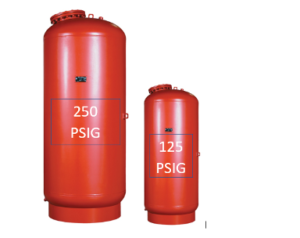 We received an interesting question from an Ohio engineer working on the renovation of a 30-story high-rise hydronic heating system. This engineer was looking out for the owner’s interests and asked if we could locate the tank at the top of the system even though the rest of the equipment was in the basement. Why do this? Can we do this? Should we do this?
We received an interesting question from an Ohio engineer working on the renovation of a 30-story high-rise hydronic heating system. This engineer was looking out for the owner’s interests and asked if we could locate the tank at the top of the system even though the rest of the equipment was in the basement. Why do this? Can we do this? Should we do this?
Bladder Expansion Tank Sizing Depends on Location.
Bell & Gossett, as well as other manufacturers, will provide a high-pressure hydronic expansion tank with 250 PSIG or 300 PSIG working pressures. The project in question is about 360 feet high. The proper fill pressure at the bottom of the system will be about 160 PSIG. If the expansion tank is sized for a 40 PSIG allowable pressure increase, the tank would be at 200 PSIG and a proper pressure relief valve sizing would dictate a maximum of 220 PSIG. Let’s see what the tank would look like with 3,000 gallons in the system at 170°F average temperature.
Bottom of System Selection:
The acceptance volume is (EW-EP) X Volume. The acceptance volume is 0.0243 X 3000 = 72.9 gallons. The tank volume will be the acceptance volume divided by the pressure limiting denominator. At the bottom of the system, the denominator will be (1-(174.7/214.7)) or about 0.186. The tank will be a minimum of 392 gallons.
This tank will have to be a series B&G B-1600 or Wessels NLA-1600 with 250 PSIG working pressure.
Top of System Selection:
The acceptance volume is (EW-EP) X Volume. The acceptance volume is 0.0243 X 3,000 = 72.9 gallons. The acceptance volume is based on temperatures and volume, so it remains the same as above.
The tank volume will be the acceptance volume divided by the pressure limiting denominator. At the top of the system, the denominator will be (1-(22.7/62.7.7)) or about 0.64. The tank will be a minimum of 115 gallons.
This tank will have to be a series B&G B-500 or Wessels NLA-500 with 125 PSIG working pressure.
Results:
The initial cost of the low-pressure smaller tank at the top of the system will be approximately 20% of the cost of the high-pressure hydronic expansion tank. This would result in thousands of dollars in savings. The size of the low-pressure tank is also smaller. In addition, the lead time of the higher pressure product and any parts required down the road may be extended.
We know that there are several good reasons to locate the tank at the top of the system. How should it be piped? How will it operate in the system? We will address that in, “Hydronic Expansion Tank Location in High-Rise Projects (Part 2)”, next week.

